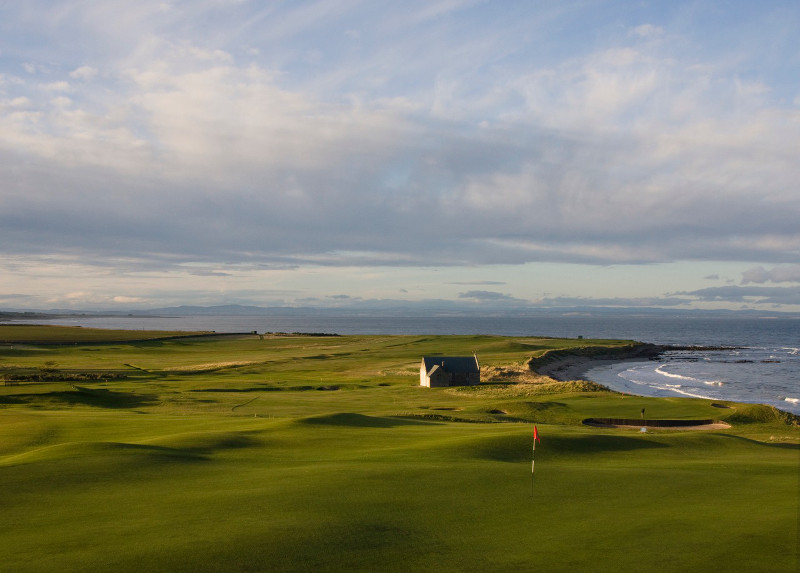The Kingdom of Fife on the east coast of Scotland is ruled by golf. The area between the Firth of Forth and Firth of Tay boasts more than 50 golf courses and a great variety of seaside links courses, inland parkland and heathland courses.
Among those courses is the most famous in the world, the Old Course of St. Andrews where golf has been played for more than five centuries. Around the «grey old town» there are more golf clubs which combine stunning courses with remarkable history. Four of these clubs, Crail Golfing Society, Scotscraig Golf Club, Lundin Golf Club and Ladybank Golf Club have formed a group called Links with History.
The group was formed around some of Scotland´s most notable golf clubs which collectively share a legacy stretching back over 700 years. Featuring links, heathland and parkland layouts, Links with History provides golfers with access to some of Scotland’s finest championship courses and its celebrated golfing past.
It is golf’s golden era preserved as it should be. With Old Tom Morris playing a key role in the development of each participating club and James Braid applying his design skills to half of this selection of .
The Links with History Golf Pass offers reduced green fees for the five courses of the four participating clubs.
Crail Golfing Society
The Crail Golfing Society was formed in 1786 and is the 7th oldest golf club in the world. The two courses, Balcomie Links and Craighead Links, combine spectacular views and extraordinary holes to provide challenging and enjoyable golf.

A combination of stunning coastal views, centuries of history and hugely enjoyable golf is what makes Balcomie Links one of Scotland’s most finely polished, golfing gems. This traditional, classic links course was laid out by the old master himself, Old Tom Morris, and opened in 1895.
Balcomie has the unusual combination of three par fives, six par threes and nine par fours, producing a tough par of 69. Extraordinary holes abound, along with those which seriously challenge and those which are more comfortable. The layout both enchants and delights, but also demands and punishes, testing all the skills in a golfer’s armoury . As well as his nerve.
With spectacular views over the sea from every hole Craighead Links is a challenging, cliff-top course. It was designed by world-renowned, American golf course architect Gil Hanse to provide golfing aficionados with a true test of their shotmaking skills in a links environment.
Scotscraig Golf Club
When Scotscraig Golf Club (the club house pictured at top of the article) was founded in 1817, there were only twelve other golf clubs in existence in the world. The course was originally laid out over six holes but was extended to nine in 1888. In 1923, the course was redesigned with the assistance of James Braid; a member of golf’s Great Triumvirate.

Scotscraig has hosted local final qualifying for the Open Championship when the tournament has been held at St Andrews for more than 20 years. There is plenty of heather and gorse to catch wayward shots.
Scotscraig is located about 10 miles from St. Andrews on the way to Carnoustie. The 18 hole, Par 71 course sits a few miles from the coastline and can be categorized as a challenging mixture of links and heathland course.
Lundin Golf Club
Near to the «Home of Golf» in St Andrews, Lundin Golf Club is well known throughout the golfing world. It is renowned as a course of rare quality and as a classical links course with great views over the Firth of Forth.
Founded in 1868 the club used to share 18 holes with Leven Links Golf Club. When golf gained popularity around the turn of the century the Old Tom Morris designed 18 holes where divided. Each club kept the nine holes close to their clubhouse.

Lundin Golf Club acquired new land and five times Open Champion, James Braid, designed the Par 71 course. He named the 14th hole, a stunning Par 3, «Perfection»;with a good reason.
From the green players enjoy a great view over Largo Bay. Narrow fairways, bunkers, burns (creeks), and ever-changing winds guarantee a testing, but rewarding, golfing experience even if the course isn’t long for modern standards (5846 meters, Par 71). The course served as a course for Final Qualifying when the Open was held at St. Andrews.
Ladybank Golf Club
Formed in 1879, Old Tom Morris was engaged to lay out the original course at Ladybank Golf Club. It consisted of six holes outward that were played in reverse on the inward half. In 1910, the course was extended to nine holes with the 18-hole course eventually being opened in 1961.
Ladybank is a rare tremendous inland course in Fife. It measures 6,800 Yards (6.218 meters) from the medal tees, making great use of its heathland terrain. It has changed a little over the years, requiring the golfer to display real precision to hit the small and often contoured greens.

There are a few doglegs between the trees where care is needed not to get blocked out. Never easy but always fun. Standing on the 1st tee, you know you are in for a treat. The club proudly displays pictures of two honorary members, Jack Nicklaus and Seve Ballesteros, who played in an exhibition match in 1983. The course also held Final Qualifying for The Open at St. Andrews.





